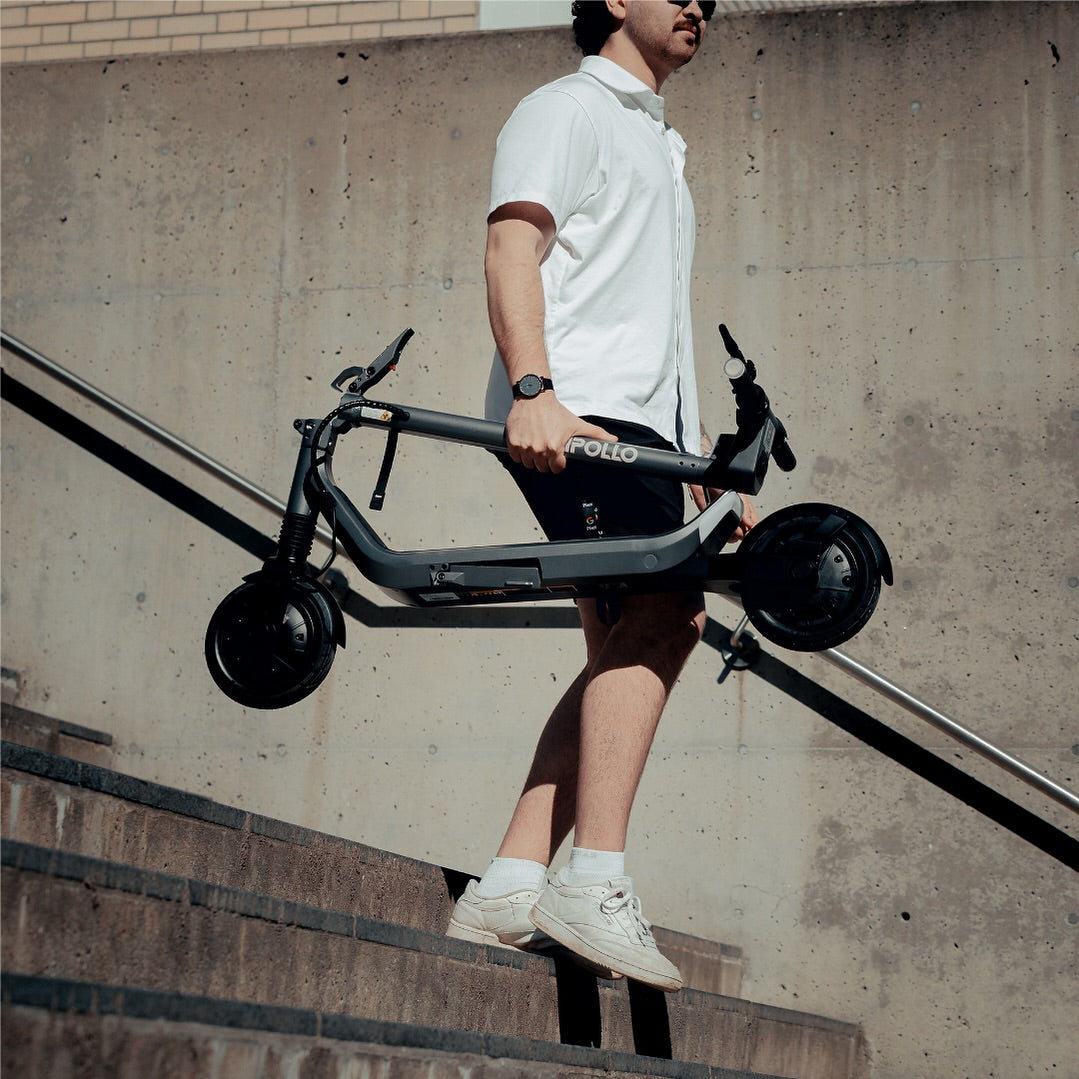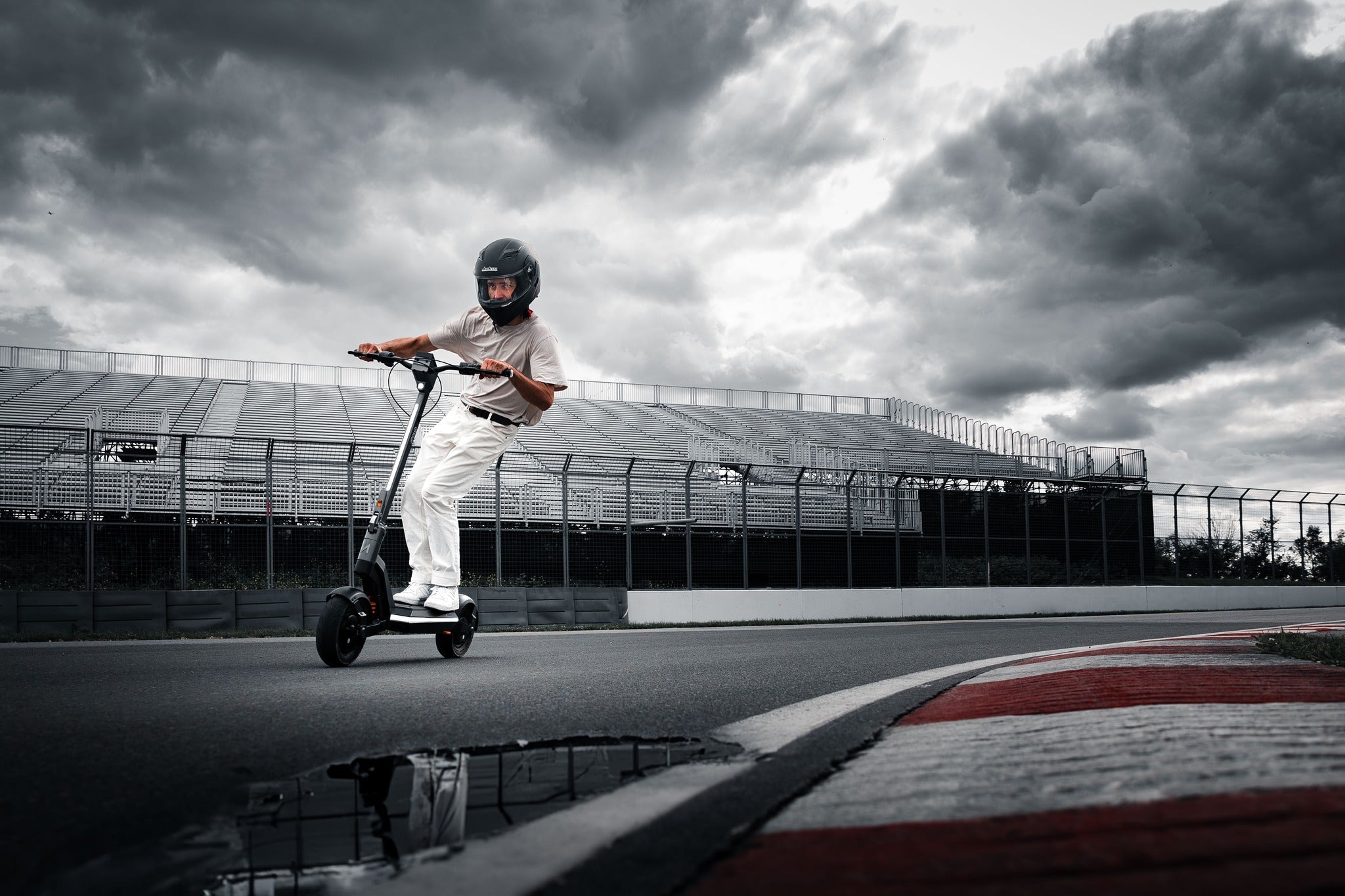Primer viaje largo en un scooter eléctrico, eh? No tienes que preocuparte por eso. Aquí tienes una guía muy útil sobre lo que debes recordar y cómo prepararte. Un buen plan es la mitad de la batalla, la otra mitad es el equipo, pero supongo que ya tienes un scooter eléctrico, así que después de leer este artículo estarás completamente preparado.

Consejos esenciales que necesita saber antes de su viaje
Planificar un viaje en scooter eléctrico, especialmente para una escapada de fin de semana, requiere algo más que subirse a su scooter y salir. Para garantizar una experiencia fluida y agradable, es fundamental prepararse adecuadamente. Estos son los consejos esenciales que necesita saber antes de embarcarse en su viaje con scooter eléctrico:
Comprender las capacidades y limitaciones de su scooter
Antes de partir, es importante que se familiarice con las capacidades y limitaciones específicas de su scooter eléctrico. Cada modelo, como el
- Duración y alcance de la batería: Determine la distancia máxima que su scooter puede recorrer con una sola carga en diversas condiciones. Factores como el peso del ciclista, la velocidad promedio y el terreno pueden afectar la distancia que puedes recorrer en un scooter eléctrico. Por ejemplo, los scooters de larga distancia diseñados para viajeros diarios pueden ofrecer una autonomía de 15 a 30 millas, pero esto puede variar mucho.
- Potencia y velocidad del motor: La potencia del motor afecta la capacidad del scooter para manejar pendientes y terrenos accidentados. Un motor más potente puede mantener la velocidad en pendientes y proporcionar una conducción más suave, lo cual es crucial para viajes más largos.
- Compatibilidad con el terreno: Compruebe si su scooter está diseñado para entornos urbanos o condiciones todoterreno más difíciles. El tipo de neumáticos, el sistema de suspensión y la distancia al suelo son factores importantes a considerar para diferentes terrenos.
Mantenimiento y comprobaciones previas al viaje
Asegurarse de que su scooter esté en óptimas condiciones es vital para un viaje seguro y agradable. El mantenimiento regular no sólo prolonga la vida útil de su scooter sino que también mejora la seguridad y el rendimiento. Las tareas clave de mantenimiento incluyen:
- Inspección y presión de neumáticos: Los neumáticos inflados correctamente mejoran la eficiencia y la seguridad de la conducción. Verifique si hay signos de desgaste o daño y asegúrese de que estén inflados a la presión recomendada por el fabricante.
- Estado de la batería del scooter eléctrico: Cargue su batería completamente antes del viaje y considere llevar un cargador o una batería adicional si su scooter lo admite. Compruebe periódicamente si hay signos de degradación de la batería, como autonomía reducida o tiempos de carga más prolongados.
- Verificación del sistema de frenos: Pruebe los frenos delanteros y traseros para asegurarse de que respondan. El freno de disco trasero te permite detenerte cuando lo necesites. Busque ruidos inusuales o reducción de la potencia de frenado y continúe con estos problemas antes de salir a la carretera. Durante los viajes largos existe un sistema de frenado muy útil que tiene la función de recuperar energía durante la frenada. Se llama RBS.
- Iluminación y visibilidad: Asegúrese de que todas las luces, incluidas las delanteras, las luces traseras y los indicadores, funcionen correctamente. Una buena iluminación es esencial para la visibilidad, especialmente si su viaje incluye conducción nocturna.
Más información: Patinete eléctrico Camping 101: todo lo que necesitas saber para un viaje épico
La verdad sobre la autonomía de los patinetes eléctricos: ¿Hasta dónde se puede viajar en un patinete eléctrico?
Comprender la autonomía de su scooter eléctrico es fundamental para planificar cualquier viaje, ya sea un trayecto corto o una escapada de fin de semana. La autonomía del scooter eléctrico determina qué tan lejos puede viajar antes de necesitar recargar.
Los factores más importantes que afectan la autonomía de su scooter eléctrico
Capacidad y tipo de batería
La batería es el corazón de la autonomía de su scooter. Generalmente medida en vatios-hora (Wh), la capacidad dicta cuánta energía puede almacenar la batería. Por ejemplo, un scooter con una batería de 500 Wh generalmente puede viajar más lejos que uno con una batería de 300 Wh. Además, el tipo de batería, como la de iones de litio, también influye en el rendimiento y la durabilidad. Las baterías de iones de litio son las mejores opciones, aunque son caras.Peso y carga del ciclista
Los pasajeros más pesados o aquellos que llevan equipaje adicional notarán una disminución en el alcance. Esto se debe a que el motor tiene que trabajar más para impulsar el peso adicional, consumiendo más energía en el proceso. Por ejemplo, si un scooter tiene una autonomía máxima de 20 millas en condiciones ideales, una carga más pesada podría reducir esta autonomía hasta entre un 20 y un 30 %.Velocidad y estilo de conducción
Conducir a velocidades más altas consume más energía de la batería. Un ritmo suave y constante es más eficiente que aceleraciones rápidas y paradas frecuentes. Muchos scooters ofrecen modos ecológicos o de ahorro de energía que limitan la velocidad máxima y la aceleración, lo que puede ayudar a ampliar la autonomía.Terreno y pendientes
El terreno plano permite una máxima eficiencia, mientras que las colinas y las superficies rugosas requieren más energía, lo que reduce el alcance. Por ejemplo, un scooter puede alcanzar su autonomía máxima en calles urbanas planas, pero ver una reducción significativa cuando se utiliza en terrenos montañosos o irregulares.Condiciones climáticas
El clima frío puede disminuir la eficiencia de la batería, acortando así el alcance. El frío o el calor extremos pueden reducir la capacidad y el rendimiento. Además, a quién le gusta conducir con mucho frío y congelarse la cola. Presión y tipo de neumáticos
Los neumáticos correctamente inflados reducen la resistencia a la rodadura, lo que ayuda a maximizar el alcance. Los neumáticos poco inflados aumentan la resistencia y el consumo de energía. Además, los neumáticos sólidos pueden ofrecer menos resistencia a la rodadura que los neumáticos inflados de aire, pero estos últimos pueden proporcionar una mejor absorción de impactos y comodidad.Uso de accesorios
Accesorios adicionales como luces, parlantes o incluso cargadores de teléfonos móviles pueden consumir energía de la batería, reduciendo así el alcance general.Planificación de paradas de carga durante su viaje en scooter eléctrico
Para viajes más largos, especialmente aquellos que exceden el rango de carga única de su scooter, planificar las paradas de carga es esencial. A continuación se explica cómo planificar eficazmente la recarga:
- Planifique los lugares de carga Antes de partir, identifique posibles lugares de carga a lo largo de su ruta. Esto podría incluir estaciones de carga públicas, cafeterías, restaurantes o incluso negocios amigables que podrían permitirle conectarse. Los sitios web y aplicaciones como PlugShare pueden ayudar a localizar estos puntos.
- Comprenda su tiempo de carga Sepa cuánto tiempo lleva recargar completamente la batería de su scooter. Algunos scooters, como el
Apollo City 2024, pueden ofrecer opciones de carga rápida, lo que reduce el tiempo de inactividad. Sin embargo, incluso con carga rápida, planifique descansos de 30 minutos a una hora, según el tamaño de la batería y la carga restante. - Lleve un cargador portátil Si es posible, lleve consigo un cargador portátil para usarlo cada vez que se detenga, ya sea para comer o descansar. Esto puede resultar especialmente útil si su viaje lo lleva a través de áreas con infraestructura de carga limitada.
- Opciones de cambio de batería Para los scooters que lo permiten, llevar una batería adicional puede efectivamente duplicar su alcance sin necesidad de detenerse para cargar. Esta es una solución práctica para viajes donde el acceso a las estaciones de carga es limitado o inexistente.
- Optimice el uso de la batería Para conservar energía, utilice modos de ahorro de energía cuando sea posible y evite aceleraciones innecesarias. Además, utilice las funciones de frenado regenerativo si su scooter las tiene, ya que pueden ayudar a recuperar algo de energía al frenar.
Consejos útiles para un fin de semana en scooter tranquilo y agradable
Planificar una escapada de fin de semana en un scooter eléctrico puede ser una experiencia encantadora, que combina la libertad de viajar con la alegría de explorar nuevos lugares. Para garantizar que su viaje sea seguro y agradable, es importante prepararse minuciosamente. A continuación se ofrecen algunos consejos de expertos que le ayudarán a aprovechar al máximo su fin de semana en scooter.

Consejos de seguridad para viajes largos en scooter eléctrico
La seguridad siempre debe ser una prioridad absoluta a la hora de planificar cualquier viaje, especialmente en un scooter eléctrico. A continuación se incluyen algunos consejos de seguridad esenciales que debe tener en cuenta en viajes largos:
1. Utilice equipo de seguridad adecuado
Casco: Un casco es una pieza de equipo de seguridad no negociable. Le protege de lesiones en la cabeza en caso de caída o colisión. Elija un casco que le quede bien y cumpla con los estándares de seguridad, como la certificación DOT o CPSC en los EE. UU.
Ropa de protección: Considere usar equipo de protección adicional, como guantes, coderas y rodilleras. Estos pueden ayudar a prevenir lesiones en caso de una caída. También se recomienda usar ropa o chalecos reflectantes para mejorar la visibilidad, especialmente si conduces en condiciones de poca luz.
2. Conozca y respete las leyes de tránsito locales
Familiarícese con las leyes y regulaciones de tránsito para scooters eléctricos en las áreas que planea visitar. Estos pueden variar ampliamente entre ciudades y estados, y abarcan aspectos como los límites de velocidad, dónde se puede circular (carriles para bicicletas versus carreteras) y requisitos de casco.
Respete siempre las señales y señales de tráfico, y practique la conducción defensiva siendo consciente de su entorno y anticipando peligros potenciales.
3. Planifica tu ruta cuidadosamente
Elija rutas que sean adecuadas para scooters, idealmente con carriles exclusivos para bicicletas o caminos menos congestionados. Evite las áreas de mucho tráfico siempre que sea posible, ya que navegar a través de un tráfico denso puede ser riesgoso.
Considere el terreno y los cambios de elevación. Las colinas empinadas pueden ser desafiantes y pueden requerir más potencia, lo que afecta el alcance de su scooter. Las rutas planas son generalmente más seguras y fáciles de gestionar.
4.Manténgase visible y comuníquese
Hágase lo más visible posible para los demás usuarios de la vía. Utilice las luces, use ropa brillante o reflectante y utilice señales con las manos para indicar los giros.
Utilice una campana o bocina para alertar a los peatones u otros ciclistas de su presencia, especialmente en espacios concurridos o compartidos.
5. Conduce de forma inteligente y mantente alerta
Evite distracciones mientras conduce, como usar el teléfono. Si necesita consultar un mapa o hacer una llamada, deténgase primero en un lugar seguro.
Manténgase hidratado y tome descansos regulares. La fatiga puede afectar su concentración y tiempo de reacción, aumentando el riesgo de accidentes.
Cuál es el viaje más largo en patinete eléctrico? Viaje sin preparación
Los entusiastas de los scooters eléctricos a menudo superan los límites de sus dispositivos para ver hasta dónde pueden llegar con una sola carga o durante varios días. Intentar un viaje largo en un scooter eléctrico sin preparación puede ser a la vez emocionante y desafiante. Si bien es posible cubrir distancias importantes, la falta de planificación puede generar obstáculos inesperados, como encontrar estaciones de carga o lidiar con condiciones climáticas adversas. Vale la pena equiparse con accesorios adicionales. Durante tu viaje te será útil un extensor de manillar






